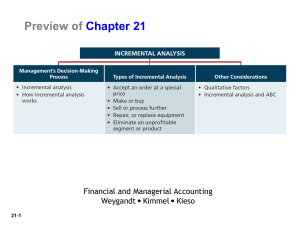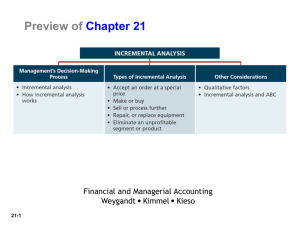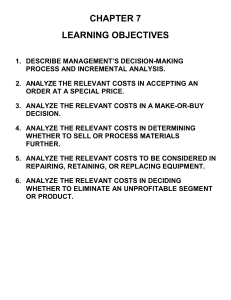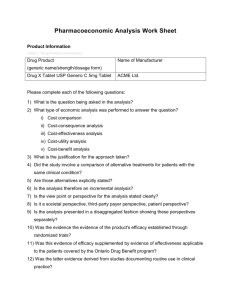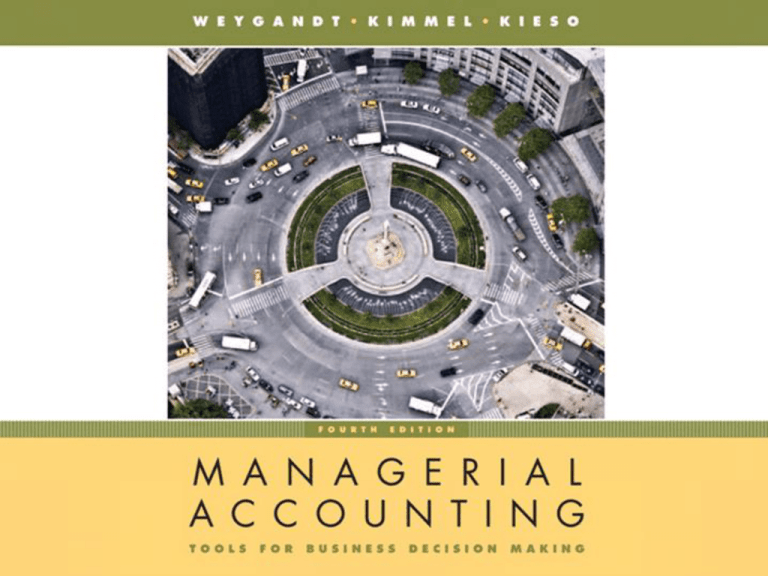
Chapter
7-1
CHAPTER 7
INCREMENTAL
ANALYSIS
Managerial Accounting, Fourth Edition
Chapter
7-2
Study Objectives
1.
Identify the steps in
management’s decisionmaking process.
2. Describe the concept of
incremental analysis.
3. Identify the relevant
costs in accepting an order
at a special price.
4. Identify the relevant
costs in a make-or-buy
decision.
Chapter
7-3
Study Objectives
5. Identify the relevant
costs in determining
whether to sell or process
materials further.
6. Identify the relevant
costs to be considered in
retaining or replacing
equipment.
7. Identify the relevant
costs in deciding whether
to eliminate an
unprofitable segment.
Chapter
7-4
Preview of Chapter
An important purpose of management accounting
is to provide managers with relevant information
for decision making.
All companies must make product decisions – to
cut prices to increase market share, to produce a
higher priced product, to change their product
mix, etc.
Management frequently uses a decision-making
process called incremental analysis.
Chapter
7-5
Incremental Analysis
Management’s
Decision-Making
Process
Types of
Incremental
Analysis
Incremental analysis
approach
Accept an order at a
special price
How incremental
analysis works
Make or buy
Sell or process further
Retain or replace
equipment
Chapter
7-6
Eliminate an
unprofitable segment
Other
Considerations
Qualitative factors
Incremental analysis
and ABC
Management’s Decision-Making Process
Decision-making is an important management
function that does not always follow a set pattern
Decisions vary significantly in scope, urgency, and
importance
Steps in management’s decision-making process:
Chapter
7-7
LO 1: Identify the steps in management’s decision-making process.
Management’s Decision-making Process
Accounting helps management in making decisions
primarily by evaluating possible courses of action
(step2) and reviewing results (step 4).
Both financial and nonfinancial information are
considered in decision-making.
Financial information includes revenues and costs
as well as their effect on profitability.
Nonfinancial information relates to factors such
as the effect of the decision on employee
turnover, the environment, or company image.
Chapter
7-8
LO 1: Identify the steps in management’s decision-making process.
Incremental Analysis Approach
Decisions involve a choice among alternative courses
of action
Financial data relevant to a decision are the data
that vary in the future among alternatives
Both costs and revenues may vary
or
Only revenues may vary
or
Only costs may vary
Chapter
7-9
LO 2: Describe the concept of incremental analysis.
Incremental Analysis
Process used to identify the financial data that
change under alternative courses of action
Identifies the probable effects of decisions on
future earnings
Involves estimates and uncertainty
Incremental analysis is also called differential
analysis because it focuses on differences
Chapter
7-10
LO 2: Describe the concept of incremental analysis.
How Incremental Analysis Works
Uses Three Important Cost Concepts
Chapter
7-11
LO 2: Describe the concept of incremental analysis.
Let’s Review
Incremental analysis is the process of identifying the
financial data that:
a.
Do not change under alternative courses of
action.
b. Change under alternative courses of action.
c.
Are mixed under alternative courses of action.
d. No correct answer is given.
Chapter
7-12
LO 2: Describe the concept of incremental analysis.
Types of Incremental Analysis
Accept an order at a special price
Make or buy components or finished
products
Sell products or process further
Retain or replace equipment
Eliminate an unprofitable business
segment
Allocate limited resources
Chapter
7-13
LO 2: Describe the concept of incremental analysis.
Accept an Order at a Special Price
Obtain additional business by
making price concessions to a
specific customer
Assumes sales of the product
in other markets would not be
affected by this special order
Assumes company is not
operating at full capacity
Chapter
7-14
LO 3: Identify the relevant costs in accepting an order at a special price.
Accept an Order at a Special Price
Example
Mexico Co. offers to buy a special order of 2,000
blenders at $11 per unit from Sunbelt.
No effect on normal sales; sufficient plant capacity
Operating at 80 percent capacity = 100,000 units
Current fixed manufacturing costs = $400,000 or $4 per unit
Variable manufacturing cost = $8 per unit
Normal selling price = $20 per unit
Based strictly on total cost of $12 per unit ($8 + $4),
reject offer as cost exceeds selling price of $11
Chapter
7-15
LO 3: Identify the relevant costs in accepting an order at a special price.
Accept an Order at a Special Price
Within existing capacity, thus no change in fixed
costs - so they are not relevant for this decision
Total variable costs change – thus they are relevant
Revenue increases $22,000; variable costs increase
$16,000
Income increases by $6,000
Accept the Special Order
Chapter
7-16
LO 3: Identify the relevant costs in accepting an order at a special price.
Let’s Review
It costs a company $14 of variable costs and $6 of
fixed costs to produce product Z200 that sells for
$30. A foreign buyer offers to purchase 3,000 units
at $18 each. If the special offer is accepted and
produced with unused capacity, net income will:
a.
Decrease $6,000.
b. Increase $6,000.
c.
Increase $12,000.
d. Increase $9,000.
Chapter
7-17
LO 3: Identify the relevant costs in accepting an order at a special price.
Make or Buy
Management must decide whether to make or buy
components.
The decision to buy parts or services rather than
making them is called outsourcing.
Example: Costs to produce 25,000 switches
Chapter
7-18
LO 4: Identify the relevant costs in a make-or-buy decision.
Make or Buy – Example Continued
Switches can be purchased for $8 per switch
(25,000 x $8 = $200,000)
At first look, the switches should be purchased;
thus saving $1 per unit
Buying the switches eliminates all variable costs,
but only $10,000 of fixed costs
$50,000 of fixed costs remain even if the
switches are purchased
Chapter
7-19
LO 4: Identify the relevant costs in a make-or-buy decision.
Make or Buy – Example Continued
The relevant costs for incremental analysis are:
Baron Company will incur $25,000 additional cost if
switches are purchased
Continue to make switches
Chapter
7-20
LO 4: Identify the relevant costs in a make-or-buy decision.
Make or Buy
Opportunity Costs
Definition: The potential benefits that may be
obtained from following an alternative course of
action.
Assume Baron Company can use the newly available
productive capacity from buying the switches to
generate additional income of $28,000 by making
another product.
If Baron makes the switches, this income is lost.
Chapter
7-21
LO 4: Identify the relevant costs in a make-or-buy decision.
Make or Buy – Opportunity Cost Example
This opportunity cost, the lost income, is
added to the “Make” column as an additional
“cost” for comparative purposes
It is now advantageous to buy the switches:
Baron Company will be $3,000 better off
Chapter
7-22
LO 4: Identify the relevant costs in a make-or-buy decision.
Let’s Review
In a make-or-buy decision, relevant costs are:
a.
Manufacturing costs that will be saved.
b. The purchase price of the units.
c.
Opportunity costs.
d. All of the above.
Chapter
7-23
LO 4: Identify the relevant costs in a make-or-buy decision.
Sell or Process Further
Many manufacturers have the option of selling a
product now or continuing to process hoping to sell
at a higher price
Decision Rule:
Process further as long as
the incremental revenue from
such processing exceeds the
incremental processing costs
Chapter
7-24
LO 5: Identify the relevant costs in determining whether
to sell or process materials further.
Sell or Process Further - Example
Single-Product Case
Cost to manufacture one unfinished table:
Selling price of unfinished unit is $50; unused capacity
can be used to finish the tables to sell for $60
Relevant unit costs of finishing tables:
Direct materials increase $2; Direct labor increases $4
Variable manufacturing overhead costs increase by $2.40 (60
percent of direct labor increase)
Fixed manufacturing costs will not increase
Chapter
7-25
LO 5: Identify the relevant costs in determining whether
to sell or process materials further.
Sell or Process Further
Incremental revenues ($10) exceed incremental costs
($8.40); Income increases $1.60 per unit
Process further
Chapter
7-26
LO 5: Identify the relevant costs in determining whether
to sell or process materials further .
Sell or Process Further
Multiple-Product Case
In many industries, a number of end-products are
produced from a single raw material and a common
production process
Multiple end-products are commonly called joint
products
Petroleum – gasoline, lubricating oil, kerosene
Meat Packing – meat, hides, bones
Chapter
7-27
LO 5: Identify the relevant costs in determining whether
to sell or process materials further.
Sell or Process Further
Multiple-Product Case
All costs incurred prior to the point at which the products are
separately identifiable (the split-off point) are called joint costs
Joint costs are (for purposes of determining product cost)
allocated to individual products on the basis of relative sales
value
Joint costs are not relevant for any sell-or-process-further
decisions
Joint product costs are sunk costs.
They have already been incurred and cannot be changed
Chapter
7-28
LO 5: Identify the relevant costs in determining whether
to sell or process materials further.
Sell or Process Further - Example
Multiple-Product Case
Marais Creamery must decide whether to:
Sell cream and skim milk now
or
Process each further before selling
Chapter
7-29
LO 5: Identify the relevant costs in determining whether
to sell or process materials further.
Sell or Process Further – Example Continued
The daily cost and revenue data for Marais Creamery are:
Chapter
7-30
LO 5: Identify the relevant costs in determining whether
to sell or process materials further.
Sell or Process Further – Example Continued
Sell cream or process further into cottage cheese?
Do not process cream further:
To do so will incur an incremental loss of $2,000
Chapter
7-31
LO 5: Identify the relevant costs in determining whether
to sell or process materials further.
Sell or Process Further
Sell skim milk or process further into condensed milk?
Marais should process the skim milk:
To do so will increase net income by $7,000
Chapter
7-32
LO 5: Identify the relevant costs in determining whether
to sell or process materials further.
Let’s Review
The decision rule in a sell-or-process-further decision
is:
process further as long as the incremental
revenue from processing exceeds:
a.
Incremental processing costs.
b. Variable processing costs.
c.
Fixed processing costs.
d. No correct answer is given.
Chapter
7-33
LO 5: Identify the relevant costs in determining whether
to sell or process materials further.
Retain or Replace Equipment
Management must decide whether a company should
continue to use an asset or replace it
Example: Assessment of replacement of a factory
machine:
Book value
Cost
Remaining useful life
Scrap value
Old Machine
$40,000
four years
-0-
New Machine
$120,000
four years
-0-
Variable costs:
Decrease from $160,000
to $125,000 annually
Chapter
7-34
LO 6: Identify the relevant costs to be considered in
retaining or replacing equipment.
Retain or Replace Equipment - Example
Replace the equipment - Lower variable manufacturing costs
more than offset cost of new equipment.
The book value of the old machine does not affect the
decision – it is a sunk cost.
However, any trade-in allowance or cash disposal value of
the old asset is relevant
Chapter
7-35
LO 6: Identify the relevant costs to be considered in
retaining or replacing equipment.
Let’s Review
In a decision to retain or replace equipment, the book
value of the old equipment is a(an):
a.
Opportunity cost.
b. Sunk cost.
c.
Incremental cost.
d. Marginal cost.
Chapter
7-36
LO 6: Identify the relevant costs to be considered in
retaining or replacing equipment.
Eliminate an Unprofitable Segment
Should the company eliminate an unprofitable
segment?
Key: Focus on relevant costs
Consider effect on related product lines
Fixed costs allocated to the unprofitable segment
must be absorbed by the other segments
Net income may decrease when an unprofitable
segment is eliminated
Decision Rule:
Retain the segment unless fixed costs eliminated
exceed the contribution margin lost
Chapter
7-37
LO 7: Identify the relevant costs in deciding whether
to eliminate an unprofitable segment.
Eliminate an Unprofitable Segment - Example
Martina Company manufactures three models of tennis
racquets:
Profitable lines:
Pro and Master
Unprofitable line:
Champ
Condensed Income Statement data:
Should the Champ line be eliminated?
Chapter
7-38
LO 7: Identify the relevant costs in deciding whether
to eliminate an unprofitable segment.
Eliminate an Unprofitable Segment - Example
If Champ is eliminated, must allocate its $30,000
share of fixed costs: 2/3 to Pro and 1/3 to Master
Revised Income Statement data:
Total income has decreased by $10,000 ($220,000 $210,000)
Chapter
7-39
LO 7: Identify the relevant costs in deciding whether
to eliminate an unprofitable segment.
Eliminate an Unprofitable Segment - Example
Incremental analysis of Champ provides the same
results:
Decision: Do not eliminate Champ
Chapter
7-40
LO 7: Identify the relevant costs in deciding whether
to eliminate an unprofitable segment.
Let’s Review
If an unprofitable segment is eliminated:
a.
Net income will always increase.
b. Variable expenses of the eliminated segment will
have to be absorbed by other segments.
c.
Fixed expenses allocated to the eliminated
segment will have to be absorbed by other
segments.
d. Net income will always decrease.
Chapter
7-41
LO 7: Identify the relevant costs in deciding whether
to eliminate an unprofitable segment .
Other Considerations in Decision Making
Many decisions involving incremental analysis have
important qualitative features that must be
considered in addition to the quantitative factors.
Example – cost of lost morale due to outsourcing or
eliminating a plant
Incremental analysis is completely consistent with
activity-based costing (ABC)
ABC often results in better identification of relevant
costs and, thus, better incremental analysis
Chapter
7-42
All About You
What is a Degree Worth?
Over a life time of work, college graduates earn an
average of $500,000 more than associate degree
holders and $900,000 more than high-school
graduates.
Tuition costs about $8,655 a year to attend a public
four-year college and about $1,359 for a public two
year institution.
About 600,000 students drop out
of four-year colleges each year.
Chapter
7-43
All About You
What is a Degree Worth?
You are working two jobs,
your grades are suffering,
you feel depressed: Should
you drop out of school?
Is it better to stay in school
even if you only take one class
each semester?
Chapter
7-44
Chapter Review - Exercise 7-1
Identify each of the following statements as true or false.
1. The first step in management’s decision-making process is
“Determine and evaluate possible courses of action.”
False
2. The final step in management’s decision-making process is
to actually make the decision.
False
3. Accounting’s contribution to management’s decisionmaking process occurs primarily in evaluating possible
courses of action and in reviewing the results.
True
4. In making business decisions, management ordinarily
considers only financial information because it is
objectively determined.
False
Chapter
7-45
Chapter Review - Exercise 7-1 Continued
Identify each of the following statements as true or false.
5. Decisions involve a choice among alternative courses of
action.
True
6. The process used to identify the financial data that
change under alternative courses of action is called
incremental analysis.
True
7. Costs that are the same under all alternative courses of
action sometimes affect the decision.
False
8. When using incremental analysis, some costs will always
change under alternative courses of action, but revenues
will not.
False
9. Variable costs will change under alternative courses of
action, but fixed costs will not.
False
Chapter
7-46
Copyright
Copyright © 2008 John Wiley & Sons, Inc. All rights reserved.
Reproduction or translation of this work beyond that permitted
in Section 117 of the 1976 United States Copyright Act without
the express written permission of the copyright owner is
unlawful. Request for further information should be addressed
to the Permissions Department, John Wiley & Sons, Inc. The
purchaser may make back-up copies for his/her own use only
and not for distribution or resale. The Publisher assumes no
responsibility for errors, omissions, or damages, caused by the
use of these programs or from the use of the information
contained herein.
Chapter
7-47

